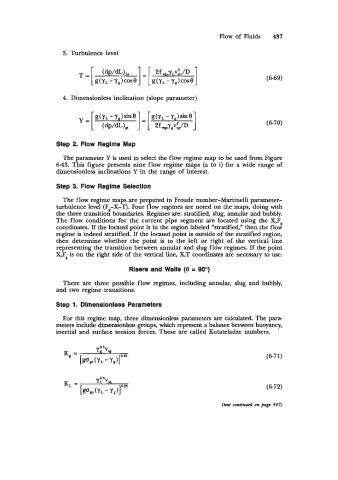Page 481 - Standard Handbook Petroleum Natural Gas Engineering VOLUME2
P. 481
Flow of Fluids 437
3. Turbulence level
(6-69)
4. Dimensionless inclination (slope parameter)
(6-70)
Step 2. Flow Regime Map
The parameter Y is used to select the flow regime map to be used from Figure
6-43. This figure presents nine flow regime maps (a to i) for a wide range of
dimensionless inclinations Y in the range of interest.
Step 3. Flow Regime Selection
The flow regime maps are prepared in Froude number-Martinelli parameter-
turbulence level (Fs-X-T). Four flow regimes are noted on the maps, doing with
the three transition boundaries. Regimes are: stratified, slug, annular and bubbly.
The flow conditions for the current pipe segment are located using the X,Fg
coordinates. If the located point is in the region labeled “stratified,” then the flow
regime is indeed stratified. If the located point is outside of the stratified region,
then determine whether the point is to the left or right of the vertical line
representing the transition between annular and slug flow regimes. If the point
X,Fg is on the right side of the vertical line, X,T coordinates are necessary to use.
Rlsers and Wells (e = SOo)
There are three possible flow regimes, including annular, slug and bubbly,
and two regime transitions.
Step 1. Dlmensionless Parameters
For this regime map, three dimensionless parameters are calculated. The para-
meters include dimensionless groups, which represent a balance between buoyancy,
inertial and surface tension forces. These are called Kutateladze numbers.
(6-71)
(6-72)
(text continued on page 447)

